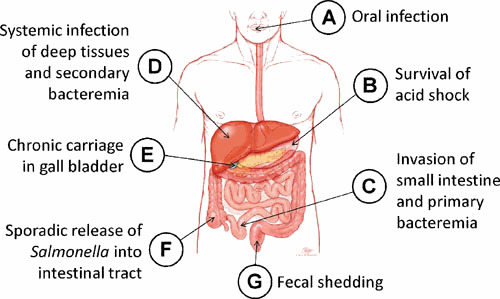Figure 1.

Pathobiology of human Salmonella infections. Infection with Salmonella is initiated following oral ingestion of contaminated food or water (A). Salmonella must then overcome potentially lethal levels of inorganic acid (H+) which produce pHs as low as 2 in the stomach of healthy adults (B). Salmonella organisms surviving the extreme acidic conditions of the stomach eventually drain into the small intestine, the portal for invasion into deeper tissues and development of systemic disease (C). Salmonella invade tissues of both villus epithelial tissue as well as lymphoid Peyer’s patches. Following transit of invading Salmonella out of the lumen and across the epithelial barrier of the small intestine, bacteria eventually gain transient access to the bloodstream to eventually colonize deep tissues including the liver (D), spleen, and bone marrow. It is at this stage that infection with S. Typhimurium is typically halted and does not progress to systemic disease in immunologically competent humans. However, S. Typhi can be released from deep tissues back into the bloodstream, triggering a more substantial secondary bacteremia which precedes the onset of classic typhoid fever. In rare cases, typhoid fever can progress to an asymptomatic chronic infection in which S. Typhi can migrate down the hepatic ducts of the liver and into the gallbladder (E), setting up a convalescent carrier state in which very high levels of organisms can be intermittently released back into the small intestine, passing through the large intestine (F) and being released in the feces (G).
